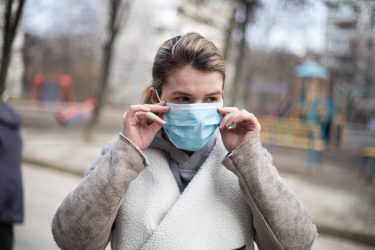One of the still most underreported consequences of the COVID-19 pandemic is the ongoing long COVID epidemic. In AHCJ’s webinar last month, “Covering long COVID, the hidden epidemic,” Monica Verduzco-Gutierrez, M.D., a rehabilitation physician at the University of Texas Health San Antonio and journalist Lygia Navarro, who both have long COVID, discussed the importance of improving coverage of this condition. An estimated 28% of people ever infected with COVID in the U.S. report having experienced long COVID symptoms, according to the latest data from the Kaiser Family Foundation.
A glance at the latest research
The good news is that 17% of those who have had long COVID report no longer having symptoms. But more discouragingly, 11% continue to live with the condition — and still no FDA-approved medications can effectively treat it yet. Among that group, commonly called “long haulers,” nearly eight out of 10 people (79%) report that long COVID symptoms limit their day-to-day activities. More than a quarter (27%) say those limitations are significant. Yet I still meet people in my everyday life who haven’t heard of long COVID, perhaps largely because media coverage of it is so sparing.
People are admittedly tired of hearing about COVID, but as we’re in the midst of the largest COVID spike since Omicron, the virus clearly isn’t tired of us. And people cannot remain vigilant about taking measures to reduce their risk of infection — and therefore their risk of long COVID — if journalists do not regularly report on it.
A scarcity in coverage
The long COVID coverage that does exist rarely comes close to conveying the tremendous burden it has on the nation’s disability services crisis, or how it’s adding to the number of people living with disability, or the fact that it’s removed anywhere from half a million to 4 million people from the workforce. Each of these under-explored angles barely scratches the surface of long COVID’s impact and why it’s so vital to improve coverage of it.
In addition to reporting on long COVID and chronic illness for years, I have continued to learn more about the diversity of the condition and those living with it since I began editing a new Medium publication, Long COVID Connection.
Long COVID’s list of potential symptoms is long — far longer in the research literature than what the CDC includes on its site — and its definition remains frustratingly nebulous as researchers and clinicians struggle to understand it, Verduzco-Gutierrez explained during AHCJ’s long COVID webinar.
Long COVID also disproportionately affects already marginalized and oppressed groups in society, Navarro said during the webinar. Women and people of color have the highest prevalence of long COVID — the same groups who already face a greater risk of medical gaslighting. Yet medical gaslighting continues to be one of the biggest barriers to diagnosis and treatment for people withlong COVID including doctors.
For example, in a 2022 qualitative study on long COVID medical gaslighting, researchers analyzed results from a survey of 334 long COVID patients in the U.S. who were active on social media. The authors reported that respondents “described encountering medical professionals who dismissed their experience, leading to lengthy diagnostic odysseys and lack of treatment options for Long Covid.” They added that “there is good reason to believe that these experiences and their contentious reframing as medical gaslighting are exacerbated by gender, class, and racial inequalities.”
Tips for improving your reporting
For all these reasons, it’s essential that journalists increase and improve the breadth of and depth of long COVID coverage. They also must understand also the challenges of reporting on the condition and how to be sensitive and thoughtful about their approach. During the AHCJ long COVID webinar, Navarro offered extensive advice on how to do that including conducting adequate research on the condition before interviews, finding diverse representations of long haulers, adapting interview styles to long haulers’ needs and finding fresh story ideas. Navarro’s slides with those tips are available here.
Two publications dedicated exclusively to long COVID coverage are The Sick Times, a new publication started by journalists Betsy Ladyzhets and Miles Griffis, which contains the most comprehensive coverage of long COVID to date, and the Long COVID Connection, a Medium publication that I edit.
Navarro’s pieces on long COVID can be read at Palabra, a multimedia site of the National Association of Hispanic Journalists, and at the University of Tulsa’s publication Switchyard Magazine. She also recommends journalists read the reporting resources on long COVID available at Long COVID Justice, which are included in the resources linked below.
Additional resources
- Long COVID: What Do the Latest Data Show? from the Kaiser Family Foundation
- Tipsheet On Covering Long COVID by Betsy Ladyzhets at IRE
- A Long COVID source list by Fiona Lowenstein and Betsy Ladyzhets, which provides information for contacting a wide diversity of people with long COVID or with expertise in long COVID who have agreed to be contacted by journalists.
- Body Politic’s comprehensive guide to covering Long COVID by Fiona Lowenstein
- How to cover COVID-19 patients sensitively by Fiona Lowenstein, Columbia Journalism Review
- Long COVID coverage often falls short, but here’s how reporters can do better by Fiona Lowenstein USC’s Annenberg Center for Health Journalism
- How to Report with Accuracy and Sensitivity on Contested Diseases by Julie Rehmeyer, The Open Notebook
- Covid-19 and Impacted Communities: A Media Communications Guide by the COVID-19 Working Group-NY
- How to Cover Long Covid, an On the Media interview with Brooke Gladstone and Fiona Lowenstein









